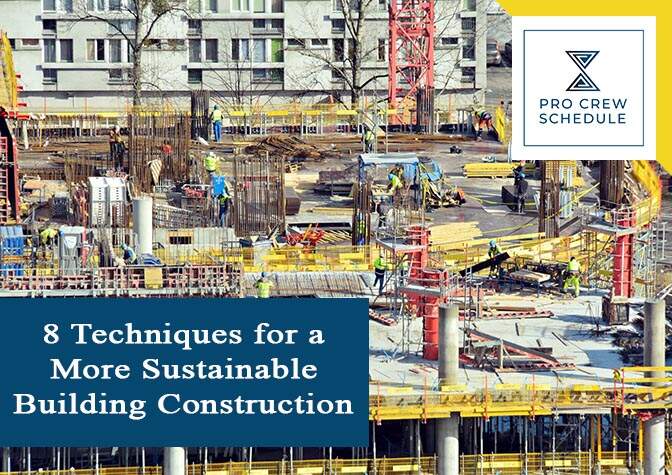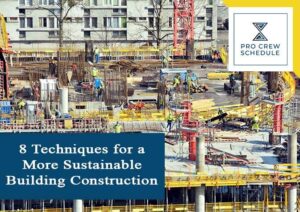Many trends come and go in the construction industry and some fall by the wayside in just a short period of time. However, other trends grow to become a critical part of the industry. In fact, sustainable construction falls under the latter. There are a good number of reasons why builders, contractors, and owners, whether private or public, are turning to sustainable construction.
Read to discover the significance of sustainable construction and the eight techniques you can apply that can help you achieve a more sustainable building construction.
Why is Sustainable Construction Important?
From energy usage to emissions, the construction industry has a significant impact on the environment. And apart from that, construction industry energy is incredibly high. The heavy machinery used in construction still relies heavily on fossil fuels. Even insufficient electricity may result in the useless burning of fossil fuels further down the energy supply line. Undoubtedly, the construction industry accounts for thirty-six percent of worldwide energy usage and forty percent CO2 emissions.
Sustainable construction is attracting more attention lately, but many don’t understand its importance and full potential. It isn’t, in fact, about the creation of the building that has a lower environmental impact. It is a new strategy in the building sector, which improves the many ways people live and build.
Moreover, sustainability is crucial for many reasons, including environmental quality and a better quality of life. To have thriving and healthy communities, clean air, a non-toxic environment, and natural resources are the primary goal and needs, and the construction sector will be the one leading for greener projects.
1. Make sustainability an integral part of your business processes
There are many strategic approaches vital for success in sustainable construction. One way to start will be building a network of suppliers and vendors who can deliver you sustainable building materials. You can also change your hiring practices to prioritize top talents who have experience in sustainable construction or train your existing trusted employees.
The key is to establish sustainability in every aspect of your business rather than forcing it into and around some areas. Ensure to use subcontractor scheduling software to have a better collaboration with your members regarding existing business approaches. They may come from different departments, but this tool serves as a central hub for everybody, keeping the communication constant and unified.
2. Modular construction to eliminate waste
Modular construction is eventually a sustainable technique that developers used to design structures much faster, with maximum resource efficiency, at a more competitive cost. Modular structures, in fact, can be built within a very controlled environment where pollution is controlled and excess of resources are minimized. The modular construction process is carefully controlled for material quality, usage and reliability.
Construction techs can be deployed to make modular construction even more efficient. The use of construction scheduling software allows builders to prepare for accurate material estimates, schedule tasks, and coordinate activities with all stakeholders. The end-result will be a high-quality structure that’s also environmentally friendly.
3. Zero Energy Construction
Zero energy consumption is a developing trend in several different buildings and homes. To produce as much energy as it takes is the main goal of a ‘zero energy’ structure, causing a zero net impact on the entire environment.
Many builders are incorporating zero energy strategies to design more durable, efficient, and sustainable structures at a very competitive cost. At this rate, builders handle multiple construction projects all the time. That is why using project scheduling software is such a big deal. Such advanced software helps them stay well-organized, whether on-site or at the office while planning and executing such projects.
To continue with zero energy construction, did you know that achieving such sustainability requires a combination of the following tips:
- Efficient air ventilation systems that diminish pollutants from surrounding air.
- Using renewable energy sources (polar and wind) to power the building.
- Better insulation materials that minimize noise pollution and leaking air.
Zero energy construction allows buildings to give as much energy to the grid as used during the year.
4. Construction Waste Management
Reducing waste is becoming more obtainable for contractors and builders as haulers have become more sophisticated in recent years. Where job sites once have trash bins for different kinds of construction waste, today they only need just one since haulers use pickers to separate materials.
You can achieve seventy-five percent landfill avoidance through their process through haulers, and you don’t have to separate materials to do it. For inner-city projects, particularly those with smaller footprints, having haulers handle materials in a single container makes it all different since space is at a premium.
You should also know that some construction materials on-site are recyclable. Concrete, in particular, can be crushed and used as aggregate beneath parking lots and for foundations. Furthermore, proper waste management can be done through manpower and when using modern tools. A software tool for project task management is ideal for tracking and monitoring waste management, giving you complete review and data.
5. Recycling Building Materials
Demolition and construction activities account for a massive amount of landfill waste, five hundred million tons, according to EPA or Environment Protection Agency. That is more than twice the amount being generated from solid waste. There’s a rising effort for contractors to divert as much waste as possible from ending up in landfills. Deconstruction, for example, as opposed to demolition, is where recyclable and reusable building components and materials are distinguished and given a second use.
Copper, steel and other metals you have onsite can be recycled. For example, concrete can also be used as aggregate for base materials and new concrete for road construction. On the other hand, Wood can be reclaimed and other components such as doors, light fixtures, and HVAC units can be used in other buildings.
When you have tons of materials like this and other extra supplies, it is time-consuming to check how it will lines up with other aspects of your business. That is why you need to use inventory management software to track and account for each piece of inventory.
6 Use of Green Building Materials
Perhaps, the most popular sustainable construction strategy is the use of green building materials. These materials are sourced from renewable sources and are also recyclable whenever the building has reached its lifespan. Green building materials are generally sourced from sustainable forests, like timber. They can also be produced from innovative manufacturing processes that lessened harmful emissions to the atmosphere.
It doesn’t change the fact that what makes a building sustainable or “green” is the building materials used to establish it. That is why repurposing and recycling building materials for future use is increasingly gaining popularity today. But then again, there’s a strong emphasis on the environmental impact of building materials used for green construction.
In fact, steel and concrete are two examples of materials produced via eco-friendly manufacturing processes. With sustainable building materials like this, new buildings and infrastructures will now have better energy efficiency and lower carbon footprints. The amount of waste that ends up in landfills can also be reduced, especially when the building needs to be demolished or renovated.
7 Flexible Space Design to Improve Functionality
Dynamic and flexible construction is another sustainable design technique that involves turning a space more functional for more than one purpose. This dynamic design trend first began with reception areas designed to serve as a lounge for both employees and guests. This particular technique is also expanding into hallways, stairways, classrooms, and dining locations. Builders and contractors are trending in designing offices turning into comfortable apartments, retail spaces to twice-up community centers, and hotels turning into condos.
By turning a previously static space more useful for a variety of functions, builders like you can reduce material usage and save more valuable resources.
8 Discourage the Usage of Paper Blueprints and Specs
This might seem trivial, but preventing the consumption of paper blueprints, specs, and drawings can save tons of trees. But most importantly, it can save a lot of your time, help turn your project faster and reduce material waste. Instead of using paper, you must invest in construction scheduling software. This software allows you and your team to schedule tasks, control various project costs, analyze the risks, manage documents and portfolios, track the project’s progress, and more.
Be it an integrated system or an internal tool, and the software will give you access to different sources of information like blueprints, digital plans, and specifications. This modern advanced tool typically offers a management system, ensuring that the documentations are correct and precise.
Key Takeaways
Historically, the construction sector has been all the time viewed as the major contributor to environmental pollution. However, the industry is working so hard to establish a more sustainable construction process. Builders are increasingly using environment-friendly construction and energy-efficient construction equipment, vehicles, and building materials.







